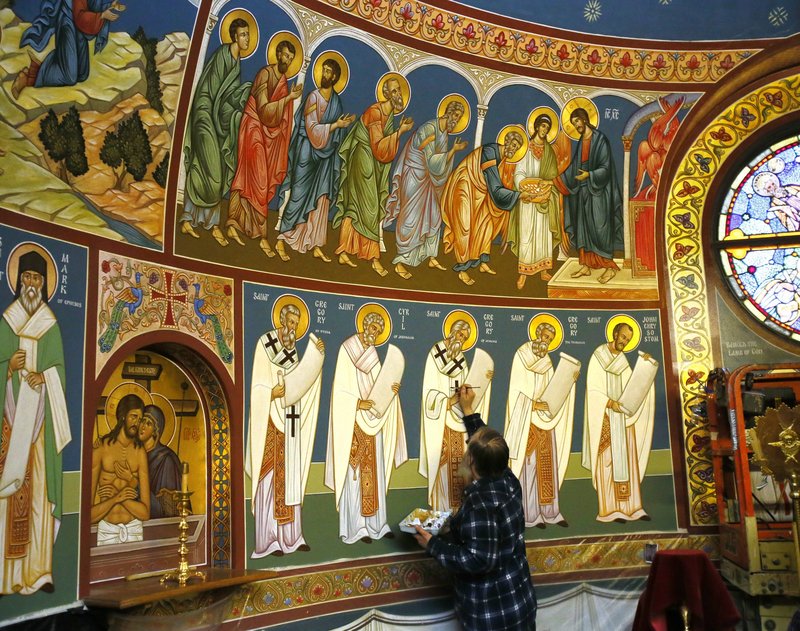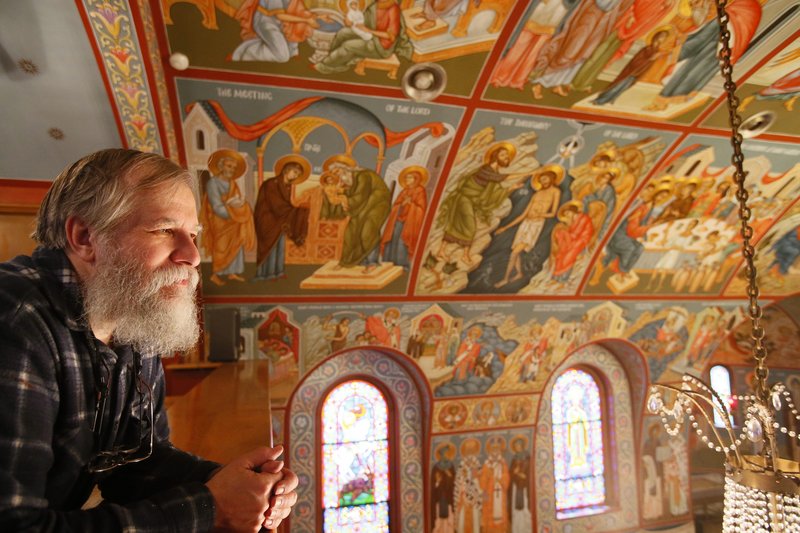LACKAWANNA, N.Y. – The religious scenes playing out on the interior walls of St. Stephen Serbian Orthodox Church could have been painted centuries ago: saints with gilded halos, winged angels hugging curved arches, calligraphic lettering helping to tell ancient stories.
But the paint is barely dry.
This brick sanctuary on a street busy with shopping and fast food was, on and off for more than six years, the canvas of the Rev. Theodore Jurewicz as he quietly practiced an art form that had its beginnings in the Roman Empire.
Paintbrush and palette in hand, the Serbian Orthodox priest filled virtually every square inch of interior wall and ceiling with icons, sacred paintings depicting the life of Christ and the angels and saints.
There are hundreds of figures in the timeless Byzantine style, drawing the eye up, around and into nooks and crannies with vivid colors that pop from a slate blue backdrop. Even the thermostat and light switch plates have been transformed.
“I was always interested in holy pictures when I was a child. I used to scribble on paper and on the walls,” Jurewicz said. “It just grew on me, I guess.”
He has been doing this work for about 40 years, often working on several Orthodox churches at a time, commuting from his Erie, Pa., church and spending a few weeks before again moving on.
“It’s nice,” said the white-bearded Jurewicz, 63, who is matter-of-fact about his talent. “You come back rested. You see your mistakes and correct them.”
St. Stephen Serbian Orthodox Church was completed just in time for the May 5 Easter celebration. The Rev. Rastko Trbuhovich, who has been there 28 years, said church leaders had casually talked about such a project for years before finally moving forward to raise funds for the $160,000 undertaking. One of Jurewicz’s mentors, a monk named Father Cyprian Pyzhov, had done some work in the Lackawanna church in the 1960s.
“We don’t worship icons, we honor them, we venerate them,” Trbuhovich said. “We use them to communicate with the person in the icon. It helps us to see them.”
“On other occasions to use icons, we would show pictures of traditional churches covered in icons,” he said as walked through the nave, which he said represents the cosmos transformed.
A 16- by 16-foot icon of the face of Christ occupies the center of St. Stephen’s arched ceiling. Traditionally, it would go in the dome if a church has one. It was the first image to appear and made believers even out of those in the congregation of 350 to 400 people who had been reluctant toward change.
“That got everyone’s attention,” Trbuhovich said, gazing up at the commanding figure.
Jurewicz used a scissor lift to reach the high points. “I’ve learned how to avoid accidents on scaffolding,” he said, “to put things up so they don’t fall off. The process is very difficult at the beginning, but then it gets increasingly easy and more rewarding.”
He follows a hierarchal pattern established in the Middle Ages. The feasts celebrating the great events in the life of Christ are on the ceiling and the saints are on the walls.
“At the beginning it’s an act of creativity. You have to figure everything out, the composition,” Jurewicz said. “It’s — I wouldn’t say stressful — but exhausting. Everything has to fit.”
He divides each wall into one-foot squares with light pencil lines and copies the grid onto graph paper. He then draws the scene on the grid and copies it from the graph paper to the wall in charcoal.
When he’s happy with the design, Jurewicz darkens the charcoal lines with paint, fills in the colors, dark to light, and finally outlines everything to finish.
While the themes are always the same at the churches he paints, Jurewicz varies the scenes, perhaps adding a shepherd in a corner or altering positions of figures.
Even in an era of church closings and consolidations across religions, Jurewicz said there is no shortage of work for an iconographer, but he shrugs off the notion that he is among the most renowned.
“There’s a lot of them now,” he said of artists worldwide who specialize in icons.
Interest seems to have grown in the last 40 years ago, Jurewicz said, following the collapse of communism in Eastern Europe.
But relatively few artists take on entire churches, especially the way Jurewicz does, working directly on the plaster walls and ceiling. Instead, many paint panels that can be mounted or on canvas that is glued to the wall.
Send questions/comments to the editors.




Success. Please wait for the page to reload. If the page does not reload within 5 seconds, please refresh the page.
Enter your email and password to access comments.
Hi, to comment on stories you must . This profile is in addition to your subscription and website login.
Already have a commenting profile? .
Invalid username/password.
Please check your email to confirm and complete your registration.
Only subscribers are eligible to post comments. Please subscribe or login first for digital access. Here’s why.
Use the form below to reset your password. When you've submitted your account email, we will send an email with a reset code.